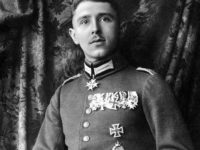Max Immelmann belonged to the most successful German fighter pilots of the first world war, whose well-known flight maneuver, the Immelmann role is still known today and a cornerstone of the tactics of a dogfight.
Origin and teenage years:
Max Immelmann was born on 21 September 1890 as son of the merchant Franz August and Gertrude Sidonie Immelmann in Dresden.
Growing up in the Dresden suburb of Weisser Hirsch, Max attended the Royal High School in the Holzhofgasse of the Dresden Neustadt, from 1902 the Ducal Gymnasium Martino-Katharineum in Brunswick after the relocation of the family.
In 1904 the family moved back to Dresden.
Military career:
From April 1905 Max Immelmann began his military service in the Royal Saxon Cadet Corps as a cadet. Already as a child, Max recognized his preference for technology and machinery, so that he left after completing his baccalaureate on April 4, 1911 to the Railroad Regiment No. 2 in Berlin-Schöneberg, hoping there his technical enthusiasm to come can.
Since there, however, the activities limited only to the application of technical provisions, Max renounced an officer's career, left in April 1912 put in the reserve and at the Technical University in Dresden with his mechanical engineering studies. During this time he was also a member of the Air Fleet Association, which strengthened his interest in flying.
Use in the First World War:
With the outbreak of the First World War was also the entry into the military service for Max Immelmann. First, he was assigned to his old regiment and conducted supervisory tours as well as practicing the field railway operation. A request for transfer to the infantry was refused, but Max was on November 12, 1914 can be transferred to the air force, where he completed his training a day later at the airfield Johannisthal and in Adlershof.
On January 31, 1915 Immelmann flew alone for the first time, on February 9 and 11 followed the pilot and field pilot exam, which he passed. He was then transferred to the Army Frontier Park 3 on the Western Front, where he carried out mostly messenger flights.
The next transfer took place on 12 April 1915 to the field flier department 10 in Vrizy to collect there as artillery pilots the first front experiences. Already 2 weeks later, the transfer to the field flier department 62 where Immelmann first flew as a reconnaissance aircraft. When hunter Fokker E.I was introduced to the division, Immelmann was able to fly this aircraft for the first time on July 30. It already had a machine gun, which made possible with the breaker gear shooting through the propeller circle and thus could be used as a real fighter aircraft. On August 1, some British Royal Aircraft Factory B.E.2 bombers flew over the airfield. Immelmann succeeded in forcing one of the enemy machines to land. For his first aerial victory he was awarded the Iron Cross 1st class.
In the coming weeks Immelmann scored more kills until he had his eighth launch on 12 January 1916 and thus received the Pour le Mérite Order.
By mid-June 1916 Immelmann had shot down 15 enemy aircraft and developed during this time one of the most famous maneuvers in history. The named after him Immelmann role should allow a pilot to sit behind the enemy aircraft in a pursuit and this can fight. The maneuver was also used in World War II. It was only with the advent of modern missiles and the battle for distance that the maneuver lost its meaning.
Whereabouts:
In the area in which the flight department of Max Immelmann was staying on June 18, 1916 several air raid alarm from advancing British bombers. Immelmann himself started at 9:30 pm with his machine to support the already in the air German pilots.
In the course of the fight, Immelmann attached himself to a falling British British bomber type F.E.2B double-decker, until he was replaced by the German pilot Mulzer.
Immelmann then went with his plane in the climb, which broke into two parts and crashed to the ground. Immelmann died at the serve.
The exact causes of the crash and why the plane broke apart are unknown until today.
The body of Max Immelmann was first laid out in the garden of the hospital of Douai, transferred to Dresden on June 25, 1916 and buried there with great sympathy.
This post is also available in:
 Deutsch (German)
Deutsch (German)  Français (French)
Français (French)  Italiano (Italian)
Italiano (Italian)  简体中文 (Chinese (Simplified))
简体中文 (Chinese (Simplified))  Русский (Russian)
Русский (Russian)  Español (Spanish)
Español (Spanish)  العربية (Arabic)
العربية (Arabic)













